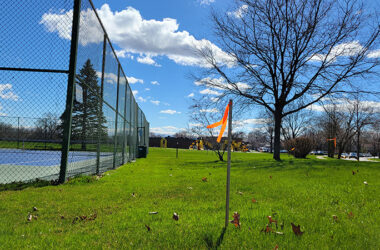When there’s no right answer, you make the best choice.
That’s what was asked of school board members in Homewood and Flossmoor in deciding how to start school this month.
In Homewood District 153 and Flossmoor District 161, students will be divided into two groups returning to school two days a week on alternate days: Monday/Wednesday or Tuesday/Thursday. The three days they’re not in school, they will be remote learning.
The districts also are offering fully remote learning for children whose parents have decided to not have them return to school.
The first day for Homewood schools is Aug. 24. The District 161 board was expected to vote on July 27 to set the first day for Flossmoor schools as Aug. 17.
The Homewood-Flossmoor High School board chose remote learning four days a week — Monday through Thursday. Students will follow a regular class schedule for seven periods, signing in for each class. Friday will be open giving students a chance to study in groups, meet with teachers, counselors and advisors, or do research.
The first day of school for H-F students is Aug. 17.
How will it go?
Educators are hopeful. They are thinking “outside the box” of tradition. Ideas created out of necessity could lead to positive changes.
“We know where we’ve been, but we’re still not sure what’s coming down that pike. And the situation is not normal by any stretch of the imagination. And it’s definitely not something we all signed up for as professionals, as parents, as community members, as our students,” said District 153 board member Jim Schmidt whose full-time job is director of guidance at H-F.
“Because these are not normal times, the normal or traditional ways of doing things is just not possible. And I struggle with that as a board member and as an educator for 27 years.”
Homewood schools Superintendent Dale Mitchell said, “We’re all shifting our mindset from being down in the dumps in March (when schools were directed by Gov. J.B. Pritzker to shift to remote learning) to what are the opportunities and other ways we can make a difference right now because our kids need us to be that strength and that power and that creativity. Students want a childhood. They want to see their teacher. They want to play sports and activities.”
At every school board meeting, parents thanked administrators and school board members.
After one District 161 survey, compiled comments totaled 31 pages. “What was striking was the thoughtfulness,” said Superintendent Dana Smith.
One woman told H-F board members she was glad she wasn’t making this decision, adding: “God bless you.”
Some days, administrators feel they have the answers. Then they get a new directive from the Illinois State Board of Education or the Centers for Disease Control and Prevention (CDC) or the Illinois Department of Public Health that forces changes to their best laid plans.
For example, Districts 153 and 161 are trying to work to meet required health and safety guidelines. Students’ temperatures need to be taken to assure no one is ill. How and when will temperatures be taken? What happens if a child gets sick at school? How will students be involved in chorus, band and orchestra? How will students social distance at lunch?
At H-F, a proposal to bring students back twice a week called for splitting the 2,800-member student body in half to provide more space for social distancing, fewer students in a classroom. But then there were other concerns, like how to find spaces for lunch when you can have no more than 50 people in a space; who will be cleaning surfaces in classrooms between classes; how can students use the bathrooms, walk the halls and the paths between North and South Buildings and still keep social distancing?
H-F Superintendent Von Mansfield said he couldn’t recommend a return to school because he didn’t feel the staff could put guarantees in place to protect the high number of students on campus.
Remote Lessons
Three, two, one – Boom!
That’s what it felt like to teachers who were counting down the days to spring break one minute and the next they were told to plan to teach for the next several weeks via computer.
Gov. J.P. Pritzker made the extraordinary decision in mid-March to immediately close all schools to protect the public as the COVID-19 virus was rampantly spreading.
The decision startled teachers and administrators. Yes, they may have done some remote learning but they hadn’t designed their own lesson plans for computer presentation, and many didn’t feel comfortable using the newest technologies.
They struggled. They created. They did their best. Reviews were mixed.
“Before this virus, we took live instruction for granted. Little did we know that it could go away or how much we would crave it once it was taken away,” said H-F teacher Jill Bonavia-Gilligani.
Now Homewood and Flossmoor students will be back in front of their computers for Remote Learning 2.0. School administrators believe what happened in March won’t happen again.
After a really sharp learning curve, teachers will be doing their best, finding ways to provide learning that will be interesting, robust and engaging, said Kathy Schaeflein, director of curriculum in District 153.
Districts have given teachers tutorials. They’ve organized learning groups. They’re sharing materials. And at the start of this year, school districts will offer professional development days for even more instructional development ideas. Staff who are comfortable with remote learning techniques will be available as coaches to fellow staff members.
Add these two terms to your 2020 vocabulary: synchronous — meaning students will learn from a teacher, either in person or remotely; asynchronous — learning will be done by the student individually.
All of this is putting a lot of strain on teachers. District 153 board member Ron Zinnerman raised concerns about how teachers are being asked to adjust to not only a new teaching method, but the threat of working in an environment where they could unknowingly contract the virus. He stressed that whatever staff needs for their emotional well-being, he will work to make certain it’s available.
“Our kids are resilient. I know people don’t think so, but our kids are resilient. They’re scared. Some of them are done with COVID, but I want our parents to know, and the staff to know, we’re here for you.”
The cost
Districts are not able to give costs for the expenses they’ll incur this school year. There are expected costs for personal protective equipment — hand sanitizer, masks, gloves, cleaning solutions, wipes.
Then there are the unknowns. Will the elementary districts need to have monitors on the buses? Will they hire staff to monitor kids health and take their temperatures before entering the building?
Districts 153 and 161 plan on hiring additional custodians to go above and beyond the traditional cleaning routines.
There are no estimates for expenses related to remote sessions, such as Google and Zoom meetings, and technical support for band and choir virtual classes and performances.
District 153 is buying desks for some classrooms. Mitchell said for years, students worked around a table in small groups learning to collaborate and share. Those tables are being set aside. Each student will have an individual desk.
District 161 provided students with devices as part of their school day so they were set when schools closed in March. District 153 had computers in classrooms, but they were not assigned to individual students. In March, the district shared devices with students who didn’t have computers at home. Since then, the district received financial support from Foundation 153, CN Railway and Woodland Community Church to underwrite the cost of machines for all students grades 3 through 8, and a limited number of devices for children in kindergarten, first and second grade.
H-F had Chromebooks in its classrooms that teachers would distribute to students, depending on the work being done. At the end of class, the devices were collected and stored back in a special cabinet that provided power for recharging the devices.
When H-F opens later this month, it will take those Chromebooks and distribute them to students. The district will be purchasing chargers for each machine. The district expects to buy Chromebooks for teachers who have been using desktop computers in their classrooms.



